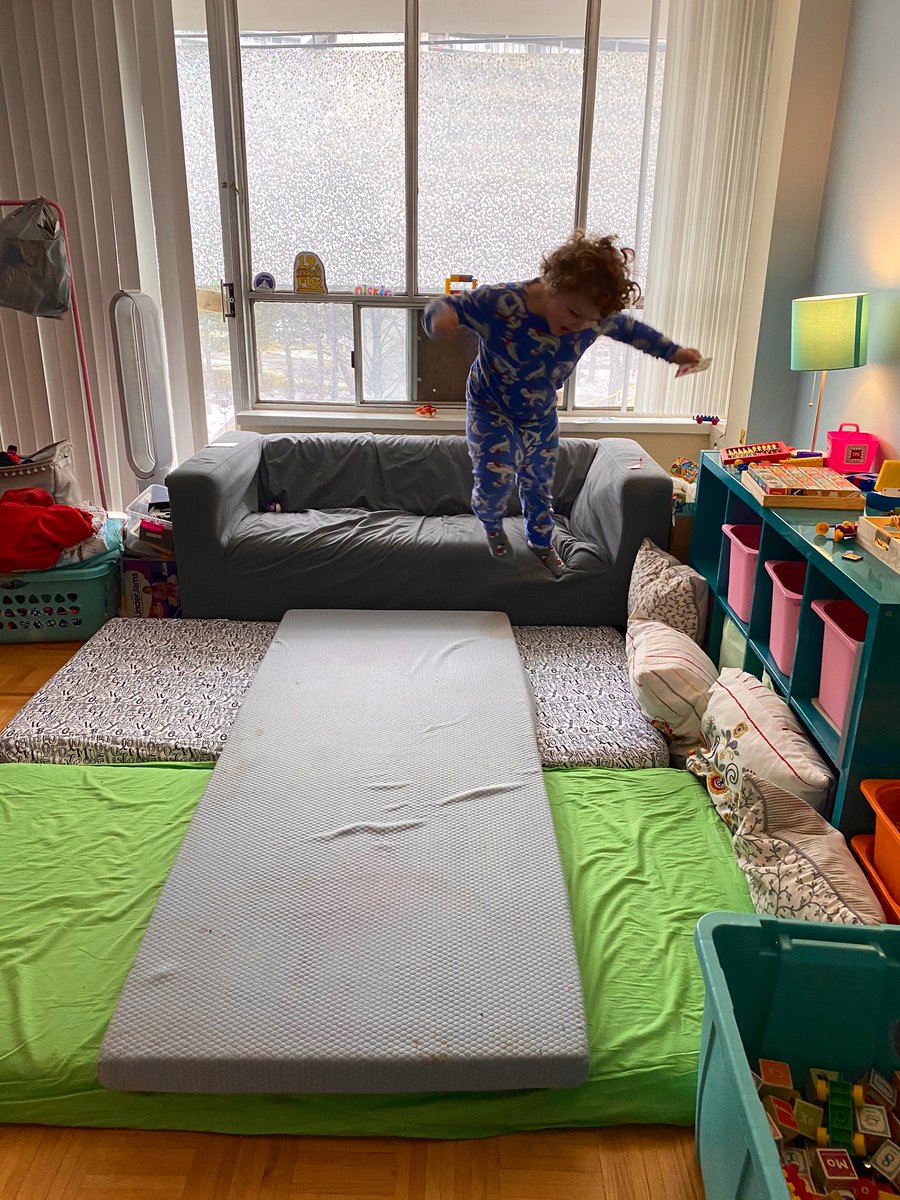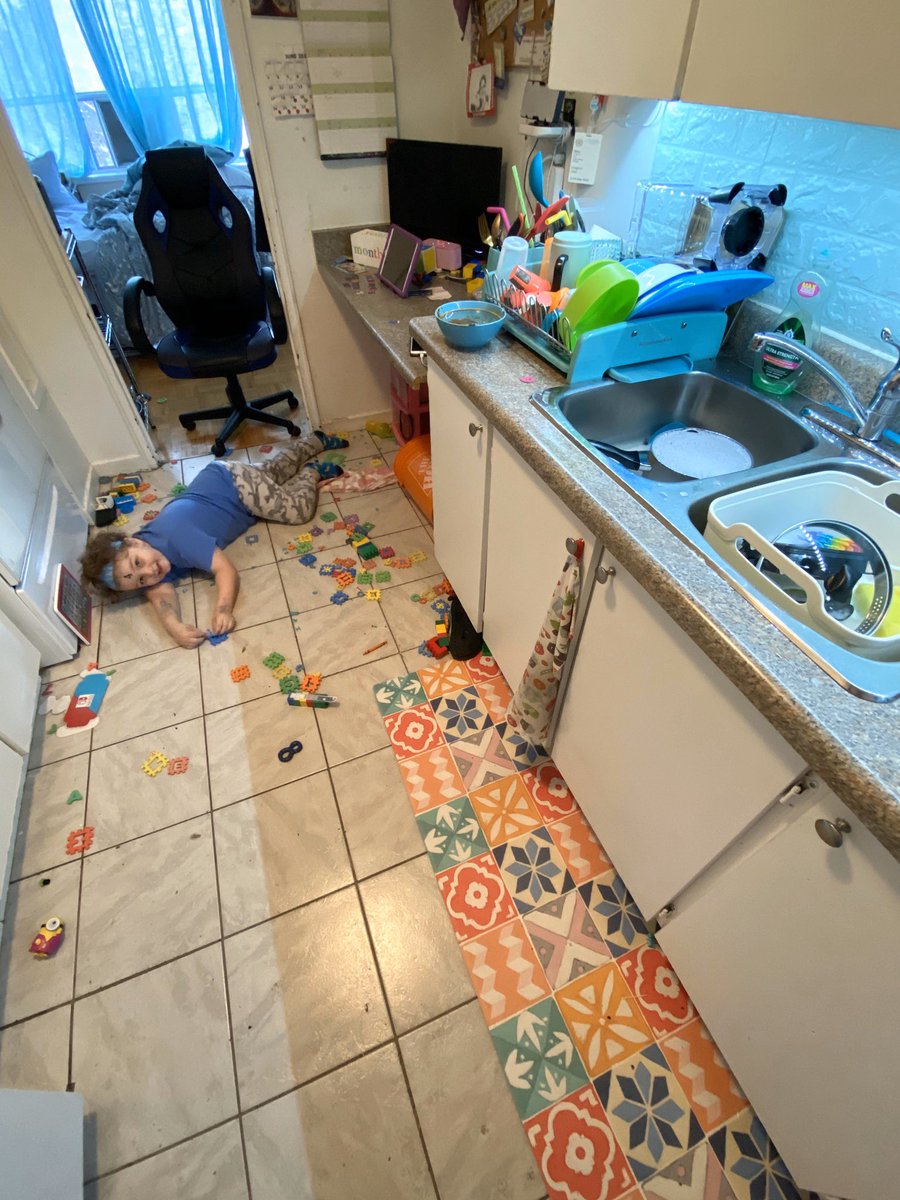Susan Cosgrove’s living room is currently occupied by a massive makeshift trampoline.

The Toronto mom of three set up the unusual piece of furniture in an attempt to keep her children occupied as they remain confined to their two-bedroom apartment during the novel coronavirus outbreak.
The toy is especially beloved by her six-year-old son, Phoenix, who lives with Autism Spectrum Disorder (ASD) and Attention Deficit Hyperactivity Disorder (ADHD). He typically attends a full-day treatment program that has academic components, but he’s been home since the COVID-19 outbreak forced schools to close.
READ MORE: Coronavirus: Britain’s Prince Charles tests positive for COVID-19
Parents across the country have had to get crafty with the ways they entertain their young ones due to COVID-19 — but Cosgrove’s job is slightly more challenging than most.
She’s constantly trying to find new ways to keep Phoenix entertained while at the same time, coordinating online schooling for her two other kids, 16-year-old Liam and 14-year-old Kaya. Liam is also on the spectrum, and Kaya has been diagnosed with ADHD and Obsessive Compulsive Disorder (OCD).
Worried about four people crammed into a two-bedroom apartment around the clock, Cosgrove asked her parents if Liam could stay with them for the duration of the outbreak. She hasn’t seen him in two weeks, and the time apart has been tough for everyone.

Now, she’s concerned about teaching Liam how to use his online classroom.
For children on the spectrum, structure and consistency from one day to the next are often crucial components for success — two things lost in the uncertainty of the coronavirus pandemic.
“Suddenly, everything that prioritized your life and kept you organized and dictated your day-to-day is gone.”

Get weekly health news
The Cosgroves aren’t alone — one in 66 Canadian children has autism, and experts say no two experiences of the disorder are the same.

Craving structure
A common feature of ASD is difficulty with changes in routine — of which there have been many since the COVID-19 outbreak began.
It’s also common for kids on the spectrum to have co-occurring ADHD, like Phoenix.
READ MORE: Sore back, neck from working from home? Quick fixes to improve your workspace
“They need a bit more movement in their daily lives, and that can be difficult with the restrictions in place right now,” Penner said.
Between caregiving, trying to keep kids happy and homeschool, the coronavirus outbreak presents a unique set of challenges for parents of children on the spectrum.
“Parents are doing a lot of heavy lifting right now. Those challenges can really be accentuated for autistic children and kids with other neurodevelopmental disorders,” said Penner.

To offset these impacts, Penner says parents should try to go with the flow instead of imposing a strict schedule.
If something is a “less preferred activity,” like homework, try to follow it up with more preferred activities, like playing outside. She also recommends adding new forms of positive reinforcement, like sticker charts, prizes or special family events, like movie night.
Return to “normalcy”
Cosgrove is less concerned about needing to stay home right now — in fact, Phoenix thinks spending 24 hours a day with his mom is “the greatest thing that’s ever happened to him” — and more worried about what will occur when social distancing requirements are lifted.
Liam, currently in Grade 11, had a very difficult start to the school year, and Cosgrove fears the pandemic may have interrupted any progress he made.
READ MORE: Quarantine that stress: Limit screen time during coronavirus outbreak, experts say
“He’s anxious … we had to work so hard to get him the support he needed with the one-to-one worker,” Cosgrove said.
Ideally, said Cosgrove, Liam’s support worker would continue to connect with him during this time away from school, but it doesn’t look like that’s going to happen.
She also worries about Phoenix losing the progress he made in therapy.

“Academically, he’s great … but I’m not a behavioural therapist,” Cosgrove said. “You’ve got to be objective and that’s certainly not my role. I can’t be objective when we’re together 24/7 in 900 square feet.”
Phoenix is in “his glory” right now, said Cosgrove, which is why she worries about the transition back to school.
READ MORE: What is an essential service? After groceries, it depends where you live in Canada
Simultaneously, Cosgrove is also trying to manage her own feelings and emotions during this time. She said her priority at the moment is working with treatment staff to plan the transition, and make it as successful as possible.
Penner recommends that parents be “kind and gracious with themselves” during this trying time.
“You don’t have to be the perfect teacher right now,” Penner said. “Everyone needs their own time and space to recharge.
“It’s okay to take time to care for yourself as a parent.”
If you need more support, said Penner, reach out to your clinician or your physician. Many have moved their services online and are ready to help.

Questions about COVID-19? Here are some things you need to know:
Health officials caution against all international travel. Returning travellers are legally obligated to self-isolate for 14 days, beginning March 26, in case they develop symptoms and to prevent spreading the virus to others. Some provinces and territories have also implemented additional recommendations or enforcement measures to ensure those returning to the area self-isolate.
Symptoms can include fever, cough and difficulty breathing — very similar to a cold or flu. Some people can develop a more severe illness. People most at risk of this include older adults and people with severe chronic medical conditions like heart, lung or kidney disease. If you develop symptoms, contact public health authorities.
To prevent the virus from spreading, experts recommend frequent handwashing and coughing into your sleeve. They also recommend minimizing contact with others, staying home as much as possible and maintaining a distance of two metres from other people if you go out.
Meghan.Collie@globalnews.ca











Comments